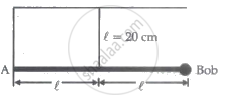Advertisements
Advertisements
प्रश्न
Write short notes on two springs connected in series.
उत्तर
- When two or more springs are connected in series, we can replace (by removing) all the springs in series with an equivalent spring (effective spring) whose net effect is the same as if all the springs are in series connection.
- Given the value of individual spring constants k1, k2, k3, ... (known quantity), we can establish a mathematical relationship to find out an effective (or equivalent) spring constant ks (unknown quantity).
- For simplicity, let us consider only two springs whose spring constants are k1 and k2 and which can be attached to a mass m as shown in Figure.
- The results thus obtained can be generalised for any number of springs in series.

Springs are connected in series - Let F be the applied force towards right as shown in Figure. Since the spring constants for different springs are different and the connection points between them are not rigidly fixed, the strings can stretch in different lengths.
- Let x1 and x2 be the elongation of springs from their equilibrium position (un-stretched position) due to the applied force F. Then, the net displacement of the mass point is x = x1 + x2 ...(i)
- From Hooke’s law, the net force

Effective spring constant in series connection
`F = -k_s(x_1 + x_2) => x_1 + x_2 = -F/K_s` ...(ii) - For springs in series connection
−k1 x1 = −k2 x2 = F
`=> x_1 = -F/k_1` and `x_2 = -F/k_2` ...(iii)
Therefore, substituting equation (iii) in equation (ii), the effective spring constant can be calculated as
`-F/k_1 - F/k_2 = -F/k_s`
`1/k_s = 1/k_1 + 1/k_2`
Or,
`k_s = (k_1k_2)/(k_1 + k_2)Nm^-1`
APPEARS IN
संबंधित प्रश्न
Define phase of S.H.M.
Which of the following quantities are always zero in a simple harmonic motion?
(a) \[\vec{F} \times \vec{a} .\]
(b) \[\vec{v} \times \vec{r} .\]
(c) \[\vec{a} \times \vec{r} .\]
(d) \[\vec{F} \times \vec{r} .\]
Assume that a tunnel is dug along a chord of the earth, at a perpendicular distance R/2 from the earth's centre where R is the radius of the earth. The wall of the tunnel is frictionless. (a) Find the gravitational force exerted by the earth on a particle of mass mplaced in the tunnel at a distance x from the centre of the tunnel. (b) Find the component of this force along the tunnel and perpendicular to the tunnel. (c) Find the normal force exerted by the wall on the particle. (d) Find the resultant force on the particle. (e) Show that the motion of the particle in the tunnel is simple harmonic and find the time period.
A simple pendulum of length 1 feet suspended from the ceiling of an elevator takes π/3 seconds to complete one oscillation. Find the acceleration of the elevator.
A uniform rod of length l is suspended by an end and is made to undergo small oscillations. Find the length of the simple pendulum having the time period equal to that of the road.
A particle is subjected to two simple harmonic motions of same time period in the same direction. The amplitude of the first motion is 3.0 cm and that of the second is 4.0 cm. Find the resultant amplitude if the phase difference between the motions is (a) 0°, (b) 60°, (c) 90°.
What is an epoch?
Write short notes on two springs connected in parallel.
Consider two simple harmonic motion along the x and y-axis having the same frequencies but different amplitudes as x = A sin (ωt + φ) (along x-axis) and y = B sin ωt (along y-axis). Then show that
`"x"^2/"A"^2 + "y"^2/"B"^2 - (2"xy")/"AB" cos φ = sin^2 φ`
and also discuss the special cases when
- φ = 0
- φ = π
- φ = `π/2`
- φ = `π/2` and A = B
- φ = `π/4`
Note: when a particle is subjected to two simple harmonic motions at right angle to each other the particle may move along different paths. Such paths are called Lissajous figures.
A weightless rigid rod with a small iron bob at the end is hinged at point A to the wall so that it can rotate in all directions. The rod is kept in the horizontal position by a vertical inextensible string of length 20 cm, fixed at its midpoint. The bob is displaced slightly, perpendicular to the plane of the rod and string. The period of small oscillations of the system in the form `(pix)/10` is ______ sec. and the value of x is ______.
(g = 10 m/s2)

